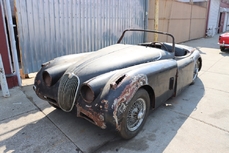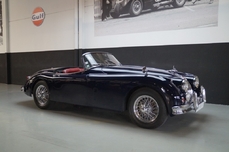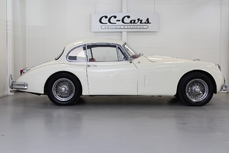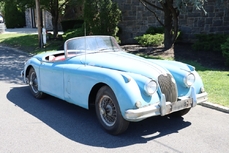Jaguar XK150 3.8 Fixed Head Coupe 1960
General description :
In 1957, Jaguar released the final and most advanced version of the XK-series of sports cars. The XK150 featured the most significant changes made since the XK120 appeared in 1949. The chassis was very similar to the outgoing 140, with independent front suspension, Salisbury rear axle, and rack and pinion steering. New for the 150, however, was the fitment of Dunlop four-wheel disc brakes, pioneered by C-Type and perfected on the D-Type at Le Mans. The standard engine was the 3.4-liter version of the XK twin-cam inline six, however for the final year of production in 1960, it was bumped to 3.8-liters and 220 horsepower in standard form, or 265 horsepower with the optional “S” package. Outwardly, the XK150 was drastically different from its earlier counterparts. The body was taller and wider to allow for a roomier cockpit and give a fresh look heading into the 1960s. In keeping with tradition, the XK150 was available as an open two-seat roadster, drophead coupe or closed fixed-head coupe. Buyers responded well to the updated, modernized styling, as well as the improved comfort and drivability and sales were up slightly over the XK140. Ultimately, the XK150 proved to be an excellent swansong to the legendary XK line, and it set the stage for the arrival of Jaguar’s next sensational sports car, the E-Type.
This striking XK150 3.8 Fixed Head Coupe is a late production model with many desirable options and features. It has had just a handful of long-term owners and it wears a high-quality and extremely well-maintained restoration that was finished in the early 1990s. The included Jaguar Heritage Certificate shows this 150 was delivered new on December 16, 1960, to Lt. Col. J W Regan. Finished in the very rare color combination of black on black, this car was specified with the 3.8-liter engine mated to a four-speed manual gearbox with overdrive. Other options include the Special Equipment package and a fabric Webasto-type sunroof which is a very rare option on the fixed head coupe. The original Periodic Maintenance Voucher booklet was first stamped in March of 1961 by Imperial Motors, Inc. of Wilmette, Illinois at 508 miles. Regular servicing continued through 1971 with the last stamp coming at 36,381 miles. It is believed that the car traveled with Lt. Col. Regan, from Illinois to New York where it was serviced by specialist George Haug Co. as late as 1966. It appears the car then traveled to England, where Murkett Bros. Ltd of Huntingdon maintained it, and finally by S.V. Robinson’s Garage of Kimbolton in 1971.
By 1974, this XK150 was back in the ‘States and in the hands of Michael Lee Bowman of Greenville, NC. An old title shows the Jaguar was traded or sold by Bowman to Cy Kay Motors of Illinois in 1983. By 1984 it had found its next long-term owner, Dr. Jim Owen of Dothan Alabama who would take exceptional care of the Jaguar for the next 30-plus years. An extensive collection of receipts for parts and service work in Owen’s name is included in the file, culminating with a comprehensive and high-quality restoration performed in the early 1990s. The body-off restoration is documented with photos and receipts, revealing the care and detail that went into returning this car to beautiful, better-than-new condition in its original black on black livery. As part of the project, the engine, gearbox, and overdrive were shipped to XK’s Unlimited for a full rebuild and the chassis was fully detailed to show-quality standards.
While the restoration is now more than 25 years old, it has been lovingly maintained and presents in very fine condition from top to bottom. The body is quite straight and the black paint remarkably good, with deep gloss and only a couple of very minute touchups and flaws visible upon close inspection. The brightwork all presents very well, with just some slight crazing apparent on some minor pieces, but otherwise appearing in very good condition. The rare original color combination is complemented by a set of black wire wheels wrapped in black wall Blockley tires which lend the car a purposeful and aggressive appearance, punctuated with original amber-lens Lucas auxiliary lights.
Like the body, the interior has aged remarkably well. Black leather seats are in excellent condition, and the upholstery remains supple. Chrome lift-latch seatbelts were added, while the rest of the cabin remains correct and true to original, down to the Perspex sun visors. Correct Wilton wool carpets are used throughout, and the vestigial rear seats appear unused. The headlining is trimmed in gray fabric, which carries over on the fully-lined Webasto sunroof. Correct black and gray leather cover the instrument panel, which houses original gauges and switchgear. The original tool roll, hammer, jack, and grease gun are in place in the boot. Also included are an original handbook and the seldom-seen service coupon booklet.
Photos show the engine and chassis were fully detailed to show-quality standards before fitting the body. The car appears to have seen light use and remains in outstanding condition, with the original, numbers-matching engine and cylinder head are appropriately detailed. It is dressed with the correct air intake, glass washer bottle, hardware, and finishes. The chassis was updated with Spax adjustable shocks and stainless steel brakes to ensure long-term reliability and improved handling. In March 2018, the engine received a top-end overhaul by Jaguar experts Coventry West of Lithonia, Georgia, which included new inlet valves, a top-end reseal, and carburetor servicing.
The XK150 is a luxurious and practical GT car with unmistakable styling and presence. This car’s powerful 3.8-liter engine and overdrive gearbox make for effortless cruising, and the large sunroof allows for an open-air experience with the reassurance of all-weather capability. With numerous rare and desirable options and a beautifully maintained restoration, this XK is ideally suited for any number of classic car rallies, tours, and events worldwide and is sure to delight its next keeper.
https://hymanltd.com/vehicles/6237
1960 Jaguar XK150 3.8 Fixed Head Coupe is listed sold on ClassicDigest in St. Louis by Mark Hyman for $125000.
Car Facts
Car type : Car Make : Jaguar Model : XK150 Model Version : 3.8 Fixed Head Coupe Engine size : 0.0 Model Year : 1960 Sub type : Coupé Location : Missouri
Sold
Seller Information
Sold
People who viewed this Jaguar XK150 also viewed similar Jaguar listed at ClassicDigest
Other cars listed for sale by this dealer
About Jaguar
Ah, the story of Jaguar, from its early days as the SS Cars Ltd. to its pinnacle with the D-type, and the street-going evolution in the form of the iconic E-type. There's something quintessentially British about this tale, and I'll narrate it as a British journalist might.In the Beginnings:
Our journey into the world of Jaguar begins in the 1930s, when a company known as SS Cars Ltd. emerged. Despite the unfortunate coincidence of their initials with the rising political tensions in Europe, they started producing stylish and performance-oriented cars. The SS 100, introduced in 1936, was a symbol of elegance and speed, setting the stage for what would become Jaguar.
The Birth of Jaguar:
As the shadows of World War II loomed, SS Cars Ltd. wisely decided to disassociate themselves from the SS initials. Thus, in 1945, they officially became Jaguar Cars Ltd., a name that would soon be synonymous with British luxury and performance.
The XK Series:
Jaguar's post-war era brought us the XK 120, a true sensation in 1948. With its sleek design and a powerful 3.4-liter inline-six engine, it became the world's fastest production car. The XK 120 was the blueprint for what lay ahead – Jaguars that blended style with speed in a uniquely British fashion.
The D-type Dominance:
Then came the D-type, a true racing legend. Introduced in 1954, it won Le Mans three times in the 1950s, showcasing Jaguar's engineering prowess. With its innovative monocoque construction and the iconic fin at the back, the D-type was the apex of Jaguar's motorsport success.
The E-type Emergence:
But the true turning point arrived in 1961 with the introduction of the E-type, often described by Enzo Ferrari as "the most beautiful car ever made." Its long bonnet, curvaceous body, and a 3.8-liter engine delivering exhilarating performance made it an instant classic. The E-type was not just a car; it was a work of art on wheels, and it could hit 150 mph on the road.
Street and Racing Success:
The E-type's beauty was matched by its capability on the track. The lightweight E-types were particularly successful in various racing events, cementing Jaguar's reputation as a force to be reckoned with in motorsport.
The Age of Refinement:
As we delve deeper into the Jaguar story, we find that the 1950s and 1960s were an age of refinement and expansion. Alongside the magnificent D-type and the E-type's iconic emergence, Jaguar introduced models that further solidified its reputation for luxury and performance.
The MK2:
In the late 1950s, Jaguar unveiled the MK2, a sports sedan that combined elegance with power. This sleek four-door saloon was a favorite of bank robbers and law enforcement alike, thanks to its exceptional speed and handling. The MK2 was a symbol of Jaguar's ability to blend sophistication with performance and had a successful racing career as well.
The XJ6:
Fast forward to 1968, and Jaguar launched a car that would define luxury saloons for decades to come – the XJ6. It was a masterpiece of engineering and design, featuring a smooth inline-six engine, independent rear suspension, and a spacious, beautifully appointed interior. The XJ6 was a symbol of British elegance and provided a ride so smooth that it seemed to glide over the road. It became the flagship model for Jaguar and set the standard for luxury saloons, showcasing a level of refinement that left competitors in awe.
The Blend of Classic and Modern:
While the MK2 and XJ6 represented the evolution of Jaguar's saloon cars, they maintained the brand's commitment to performance and luxury. These cars didn't just belong on the racetrack; they were equally at home cruising down the grand boulevards or gliding through the English countryside.
The Challenges of Change:
However, as the 1970s arrived, Jaguar, like many British automakers, faced financial challenges and changes in ownership. The British Leyland era brought both opportunities and struggles, as the brand navigated through various mergers and transitions.
Nevertheless, the legacy of the MK2 and XJ6, along with the D-type and E-type, continues to define Jaguar as a manufacturer that combines timeless elegance with a spirit of performance. These classic models, whether driven on winding roads or parked as collectors' treasures, serve as a testament to Jaguar's enduring presence in the world of automotive excellence.
The Jaguar story, from its early days as SS Cars Ltd. to the creation of automotive icons like the E-type, MK2, and XJ6, is a journey that reflects the very essence of British motoring – a blend of luxury, power, and style that continues to captivate enthusiasts and connoisseurs alike.











